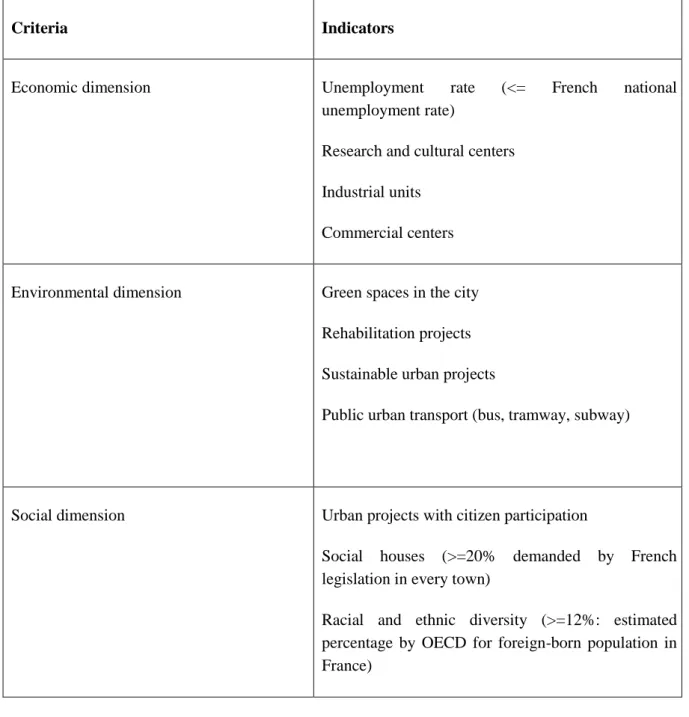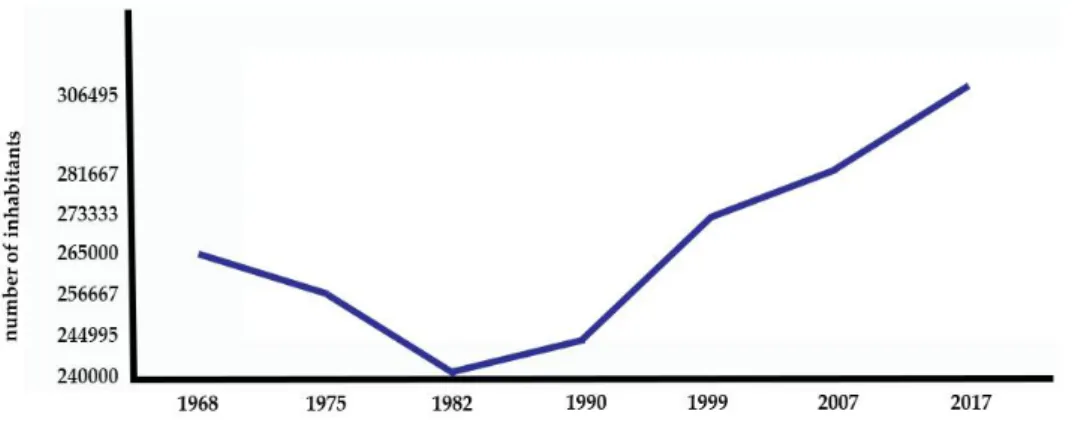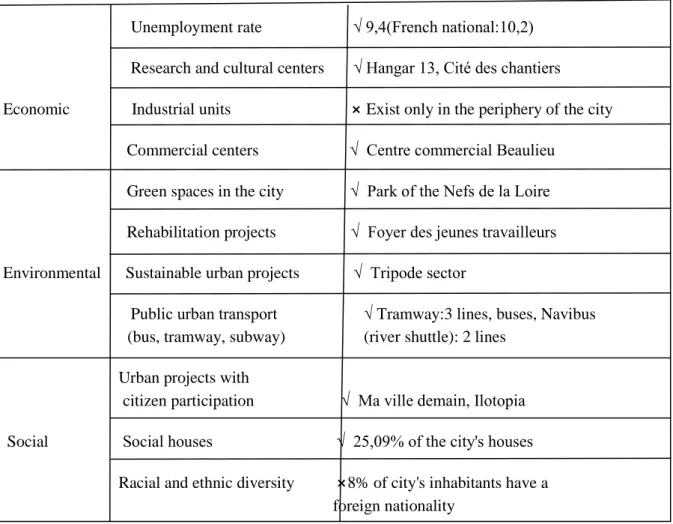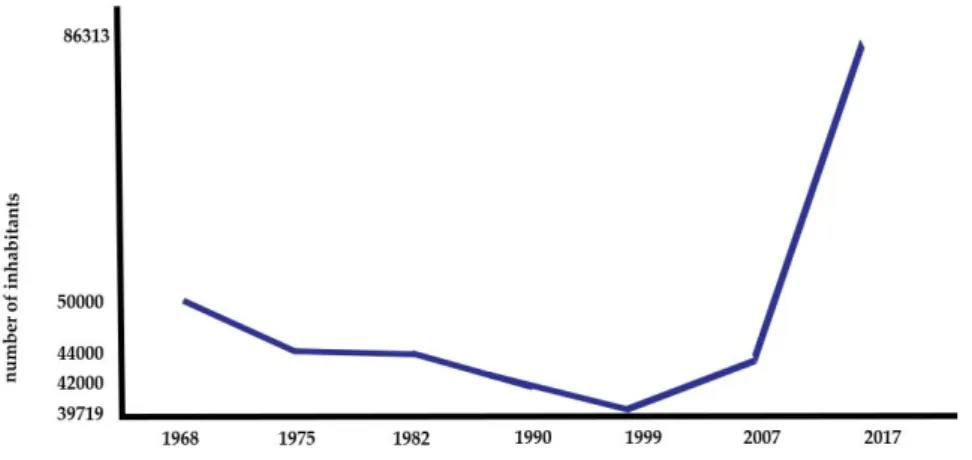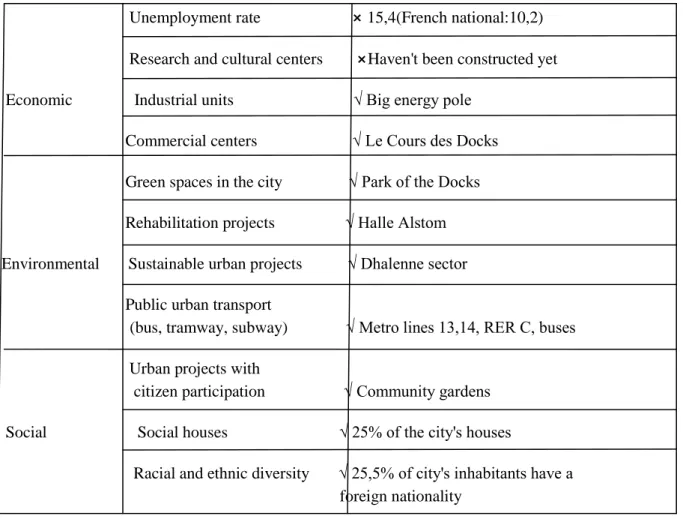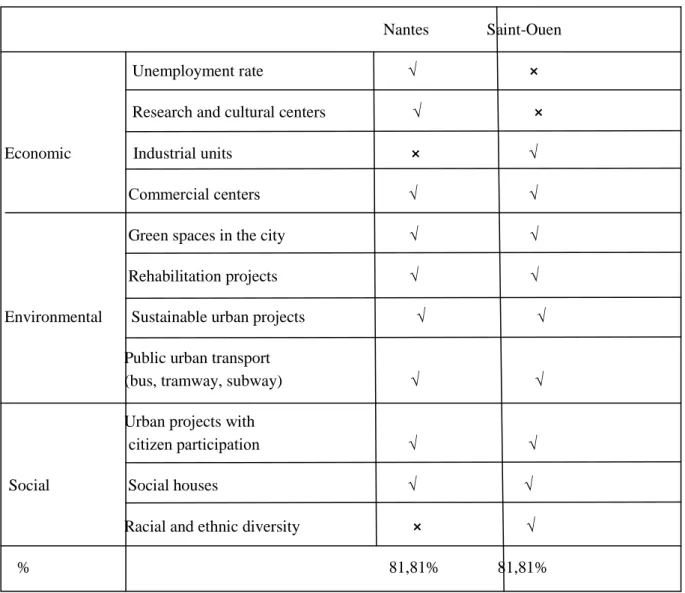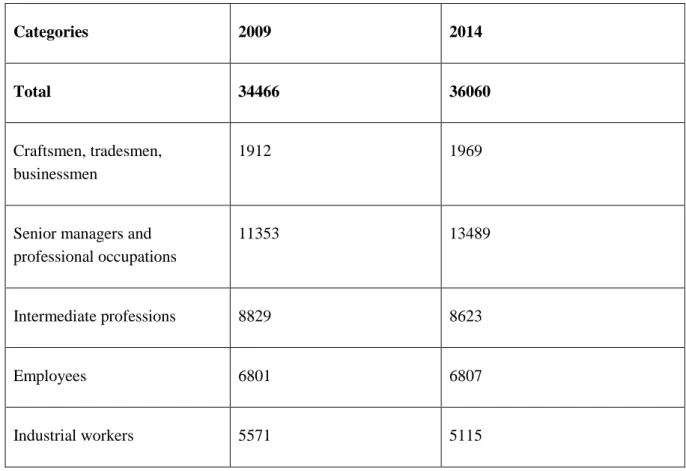HAL Id: hal-02190090
https://hal.archives-ouvertes.fr/hal-02190090
Submitted on 22 Jul 2019
HAL is a multi-disciplinary open access archive for the deposit and dissemination of sci-entific research documents, whether they are pub-lished or not. The documents may come from teaching and research institutions in France or abroad, or from public or private research centers.
L’archive ouverte pluridisciplinaire HAL, est destinée au dépôt et à la diffusion de documents scientifiques de niveau recherche, publiés ou non, émanant des établissements d’enseignement et de recherche français ou étrangers, des laboratoires publics ou privés.
Shrinking cities and sustainability Deindustrialization
and urban shrinkage. Achieving urban sustainability in
former industrial cities in France: the case studies of
Nantes and Saint-Ouen
Varvara Toura
To cite this version:
Varvara Toura. Shrinking cities and sustainability Deindustrialization and urban shrinkage. Achieving urban sustainability in former industrial cities in France: the case studies of Nantes and Saint-Ouen. AESOP, Jul 2019, Venice, Italy. �hal-02190090�
Shrinking cities and sustainability
Deindustrialization and urban shrinkage. Achieving
urban sustainability in former industrial cities in France:
the case studies of Nantes and Saint-Ouen
Varvara Toura
11Géographie-Cités/Ecole doctorale de l'EHESS, Paris, France, valiatoura@gmail.com
Abstract: Population decline in former industrial cities is an undeniable fact and preparing to
respond to it is a necessity. In my research urban sustainability is defined as a process to recover from social and economic recession which are usually linked to deindustrialization. The main goal is to survey how Nantes and Saint-Ouen became resilient after the period of deindustrialization and if they have the needed capacities of urban sustainability in dealing with population decline. The research method is descriptive-analytic. The descriptive method is used in order to define urban sustainability and relate it to previous studies in shrinking cities. The analytic method is used in order to identify the reasons that led to the population decline and the correlations between sustainable urban development and demographic evolution. The performed analyses included a combination of quantitative and qualitative methods. The outcome revealed that the two cities have reached the goal of sustainable urban development as they almost doubled their population since 2000. The final conclusion is that the urban policies implemented by local authorities as long as the economic decisions taken by local enterprises can assist Nantes and Saint-Ouen inhabitants to encounter to social and economic recession resulting from deindustrialization.
Keywords: shrinking city, population decline, sustainable urban development, urban resilience
Introduction
Urban resilience like sustainable development is a multi-dimensional approach that refers to economic development, social cohesion and environmental protection. In the context of former industrial cities achieving urban resilience seeks to increase the number of city's inhabitants and at the same time develop a new balanced city model. A city is considered as sustainable and resilient when not only achieves the goals of sustainable development, but also when it takes measures against possible crisis (like significant population decline) or, when it is needed, manages crisis that have arisen. The crisis that a city can face include not only the population decline but also issues related to the organization and administration of the city like social cohesion, economic growth and environmental protection. In this research, the cities of Nantes and Saint-Ouen have been chosen as case studies for their population decline as a consequence of the local deindustrialization. The research tries to survey how the urban resilience policies implemented by local authorities in the two cities contributed to significant population increase especially since 2000. From the municipal archives of the two cities we can see that the closure of local industries in the late 1980's led to a population decline but since the
beginning of projects of urban renewal at neighborhood level in the early 2000's both of the two cities doubled their population. The main goal of this research is to survey how Nantes and Saint-Ouen become resilient after the period of deindustrialization and if they have the needed capacities in dealing with population decline. The two main questions raised in the research are:
- Are the two study areas considered resilient in terms of the criteria adopted in the present study? - Are the social, economic and environmental capacities of the two study areas in accordance with the needs of the local communities in order to achieve population increase?
Methodology
The method adopted for the research was the descriptive-analytic, in which the descriptive method is used in order to link the current research with previous studies and related literature by searching for common definitions of urban resilience and shrinking city and the correlation between urban resilience and demographic evolution was preformed through an analytic method.
The analysis of the two case studies was performed by using a combination of quantitative and qualitative techniques. The quantitative included the analysis of demographic and economic data taken from the two municipalities and the French national institute for statistics and economic studies. The qualitative included the analysis of interviews with local authorities, inhabitants and the teams of architects and urban planners that participated in the projects of urban renewal of the two case studies. Moreover, criteria have been proposed in order to measure the resilience of Nantes and Saint-Ouen which will be discussed in detail later.
Definitions and concepts
Environmental degradation, social inequalities, economic recession and population decline are among the risks that threaten shrinking cities at international level, resulting in the transformation of their spatial and social identity. The close interactions of these factors affect the organization of cities and for many researchers a way to manage their possible impact is through a systemic approach (De Falco, 2018). In the context of the study we define shrinking city as a city which faces population decline due to changing contexts and trends in economy, politics and spatial development that have an impact on urban development at local level (Haase et al, 2014).
Several definitions of urban resilience are available showing that the notion is multi-dimensional. There are definitions derived from physical sciences (Carpenter et al, 2001) while other researchers correlate urban resilience and sustainable development focusing on natural, economic and environmental characteristics of urban systems for effective futures stability (Thornbush et al, 2013). In the context of the current study we will adopt the definition of Lu and Stead who define urban resilience as the ability of the city to absorb abnormalities while maintaining function and structure (Lu, Stead, 2013) as the cities we analyze managed to recover population decline and at the same time they preserved their industrial identity.
In the current study we will focus on three dimensions of urban resilience (economic, environmental and social) and also to the correlations between economic and environmental resilience and social resilience and citizen engagement. The question of integrating urban resilience in the procedures of
urban planning is nowadays vital, especially in shrinking cities, even though there are still difficulties in implementing its three dimensions (economic growth, social cohesion, environmental protection) at city level. In the report of World Bank entitled Ecocities2: Ecological cities as economic cities we can see the difficulties in integrating the three dimensions identified of urban resilience in the studies of international organizations, but also the possible correlation between economic growth and environmental protection in the procedures of sustainable urban planning (World Bank, 2010).
Economic and environmental dimensions of urban resilience
For many researchers like the French, Lascoumes and Tourraine, the possible correlation between the economic and environmental dimensions of urban resilience is already addressed in French public urban policies (Lascoumes, 2001 and Tourraine, 1999). At international level we can see in many reports published after the Conference of the Parties organized by United Nations in 1992 a possible correlation between the two dimensions of urban resilience in the context of sustainable development (United Nations, 1992). In all these reports we can identify an important point for the current research in French industrial cities which is the impact that have the economic activities in the natural environment and in human living conditions. In the context of French industrial cities we should mention the researches of Jacques Theys who mentions that in order to achieve urban resilience in former industrial cities we must balance the economic growth with the environmental and social issues (Theys, 2000).
The element that interests us from all those theoretical debates in the current research for achieving urban resilience in French industrial cities is how we can implement at city level economic policies, inscribed in the context of dynamic resilience, that respect at the same time the environment and allow it to be reconstructed as in pre-industrial era. We will later focus on the analysis of the economic and environmental dimensions of the urban policies implemented in our two case studies, Nantes and Saint-Ouen, and how these policies contributed to achieving urban resilience at city level.
Social dimension of urban resilience
The social dimension of urban resilience has been examined by researchers across a multitude of academic disciplines as it is a component of community resilience. In the context of the current study we will analyze the notion in a broader context which is the social cohesion in order to identify the correlations between citizen engagement and social resilience.The discussion about engaging citizens in the procedures of urban planning dates back in the 1960's and has its roots in social movements like May 1968 in France (Lefevre, 1968). In the context of urban resilience it is interesting to study how the collaboration between urban planners and citizens in the processes of neighborhood planning contributes to achieving better living conditions for all citizens as a response to social inequalities identified in most cities worldwide and which potentially could lead to social resilience.
At international level the interest to engage citizens in the processes of neighborhood planning starts in 1990 and is linked to preoccupations about environmental protection and urban resilience (Guerard, 2004). We can see in quantitative researches of the era in French industrial cities that there was a significant interest by citizens to participate in community planning as a response to global preoccupations about urban resilience (Rui, 2004). For many French researchers like Hoffman-Martinot and Sorbets the direct participation of groups of citizens in the processes of decision making
at neighborhood level helps to integrate in communities marginalized groups (for example immigrants) and thus achieve social cohesion (Hoffman-Martinot and Sorbets, 2003).
In the context of the research about social resilience the elements that interest us from all those theoretical discussions are the tools and methods used by urban planners and local authorities in order to engage citizens in the processes of neighborhood planning. Another significant point to mention in the analysis of social resilience is the role of professional associations that accompany citizens in the design processes while encouraging marginalized groups like immigrants to actively be involved in these processes.
We will later focus on the social dimension of the urban policies implemented in our two case studies, Nantes and Saint-Ouen, and how these policies contributed to social cohesion and urban resilience at city level.
Process analysis
The analysis and the measurement of the urban resilience of Nantes and Saint-Ouen follow the steps mentioned in Figure 1. In the first step of the study we identified several indicators through our empirical research in the two cities (personal observations, data from interviews) that could potentially lead to urban resilience if appropriate urban policies are implemented at city level. In the second step of the current study we defined several criteriain order to analyze and evaluate the three dimensions of urban resilience that we previously mentioned based on the indicators identified through the empirical research. In the third step, according to these criteria we evaluated whether the two cities accomplish them or not from a scale rated 0% (none urban resilience policy implemented at city level) to 100% (resilient city). In the context of the study we assume that each criteria has the same level of importance in measuring the urban resilience of Nantes and Saint-Ouen.
Figure 1. The steps of process analysis and evaluation of urban resilience in Nantes and Saint-Ouen Indicators and criteria of measurement of urban resilience
The multi-dimensional notion of urban resilience (economic, environmental, social) made essential to consider all these dimensions and citizen engagement, as social capital is associated with social resilience, in order to define the criteria of measurement of urban resilience in Nantes and Saint-Ouen. From the empirical research in the two cities we identified several indicators for measuring urban resilience, focusing on the study of urban projects at different levels (macro and micro). At macro level, urban renewal projects in former industrial sites due to their strategic position (high-density areas usually at the core of cities) allow urban planners to propose new economic activities and land uses in order to reconvert these sites and thus lead to economic resilience through their reconstruction.
Identification of indicators (empirical research) Definition of criteria Conducting a survey and evaluating the criteria Conclusion
At micro level, public spaces (parks, squares, play areas, libraries, cultural centers) are the places where people of different ethnic groups meet and create social relations.
The same indicators are used in other models of measuring urban resilience like Sustainable Livehood Framework (Department for International Development, 2000) and City Resilience Framework (Arup, 2015). The combination of these models allows us to measure urban resilience in cities facing population decline. In Sustainable Livehood Framework, resilience is defined as the recovery of an urban system from stresses and shocks while maintaining its capabilities and assets both now and in the future. In City Resilience Framework, resilience is defined as the capacity of cities to function so that the people living and working in them survive no matter what stresses they encounter. In our case studies of Nantes and Saint-Ouen the definition of urban resilience provided in City Resilience Framework becomes conceptually relevant as sudden shocks, like the closure of industrial units, threaten the collapse of the social tissue. According to these models the identified indicators are organized in three categories which consist the defined criteria for measuring the urban resilience in Nantes and Saint-Ouen. They are briefly presented in Table 1.
The economic dimension of resilience refers on one hand to the ability of a system to limit the magnitude of immediate losses and on the other hand to the ability to reconstruct and recover. In this context we identified for our study four indicators.
Unemployment rate. This indicator implies the correlation of professional activity with economic prosperity of a community. In the context of our study the high unemployment rate that the two cities had in the early 1990's led to their population decline. For the qualification of the two case studies as economic resilient cities, we compare their unemployment rate with the French national one in order to underline the good policies implemented at local level.
Research and cultural centers. Combination of expert and common knowledge allows the exchange of data and information that could potentially lead to the solution of collective problems. Both of these indicators in the French context contribute to the creation of new working positions (researchers, art curators), especially in medium size cities and lead to the reduction of unemployment rate.
Industrial units. The case studies of the current study are former industrial cities and it is reasonable to examine if industrial activity continues after their deindustrialization era. The industrial activity is directly linked with economic prosperity of these cities as most of their inhabitants work on this field.
Commercial centers. In the French context this indicator usually refers to a greater scale of that of a city, (intercommunalité) which includes a network of cities whose inhabitants visit commercial centers in a weekly basis for leisure or shopping. This indicator could also be considered as a parameter of social resilience but in the current study we will focus on its ability to bring economic prosperity to a city.
The environmental dimension of resilience refers to the capacity of a system to absorb disturbance and reorganize while undergoing change. In this context we identified for our study four indicators.
Green spaces in the city. In the context of our study we are interested to focus on the possible correlation between economic and environmental resilience as in France the presence of green spaces in the city is a parameter to attract people with high incomes.
Rehabilitation projects. This indicator refers to the ability of reversibility of a city in order to be prepared for the needs of its inhabitants in the present and in the future. Spatial reversibility contributes to the reduction of the ecological footprint of a city as the need to construct new buildings is covered by the rehabilitation of old buildings.
Sustainable urban projects. Sustainability in the new urban projects of a city is a complementary parameter to rehabilitation projects as both contribute to the reduction of the ecological footprint of a city. It mainly refers to the use of eco-friendly materials to the new constructions but also to the form of the buildings.
Public urban transport. This indicator refers on one hand to the accessibility of urban space by all users, especially the weak ones (elderly, children, user with mobility impairments) and on the other hand to the quality of cities' environment through the reduction of air pollution. The social dimension of resilience refers to the capacity of people and communities to deal with external stresses and shocks focusing on community preparedness as a response to internal or external risks. In this context we identified for our study three indicators.
Urban projects with citizen participation. This indicator refers to the ability of a city to generate social capital based on its inhabitants' needs. Social interactions especially on issues as urban design projects facilitate information sharing and collaboration.
Social houses. A typical parameter of measuring social resilience in France is the number of social houses of a city. According to French legislation the percentage of social houses of a city has to be at least 20% of the total amount of houses that exist in the city (Loi relative à la solidarité et au renouvellement urbains, 2000, article 55). For the qualification of the two case studies as social resilient cities, we compare their percentage with the minimum percentage demanded by French legislation.
Racial and ethnic diversity. The presence in a city of people with different racial or ethnic origins is a means of social inclusion as it ensures that each individual will have access to the goods produced in a city. In order to qualify the two case studies of the current research as social resilient cities we compare their percentage of foreign-born inhabitants with the French national percentage. We should mention that a law from 1872 (Bleich, 2001) prohibits the French Republic from conducting census by making any officialized distinction between its citizens in terms of race or religious beliefs. In the context of our study we used the national percentage of foreign-born population for France published in the database of Organization for Economic Co-operation and Development (Organization for Economic Co-operation and Development (OECD),2018).
Table 1. Criteria and indicators defined in the current study for measuring the different dimensions of urban resilience
Case studies
Nantes is located in the west of France with an area of about 6500 hectares. Its population in 2017 was about 300000 inhabitants. Nantes, which is known for its projects of urban renewal as Ile-de-Nantes as we can see in Figures 2 and 3, was chosen as a case study due to the significant population decline that faced after the closure of the local industries in the late 1980's.
The second case study Saint-Ouen is a city in the Seine-Saint-Denis department. It is located in the northern suburbs of Paris with an area of about 430 hectares. Its population in 2017 was about 90000 inhabitants. Saint-Ouen, which is known for its industrial activities since 19th century, faced as Nantes a significant population decline in the late 1980's due to the departure of local industries in the
Criteria Indicators
Economic dimension Unemployment rate (<= French national
unemployment rate)
Research and cultural centers Industrial units
Commercial centers
Environmental dimension Green spaces in the city
Rehabilitation projects Sustainable urban projects
Public urban transport (bus, tramway, subway)
Social dimension Urban projects with citizen participation
Social houses (>=20% demanded by French legislation in every town)
Racial and ethnic diversity (>=12%: estimated percentage by OECD for foreign-born population in France)
periphery of the city. Nowadays, the city is known for its projects of urban renewal as the Docks-de-Seine as we can see in Figures 4 and 5 that started since 2005.
The two case studies chosen show a different vision of the issue of urban resilience policies as they were not implemented at the same period. In the current research we won't compare the urban resilience policies of the two cities but instead we will present them in a chronological sequence, starting from Nantes where urban resilience policies were implemented first, in order to understand the evolution of the notion of urban resilience in French industrial cities.
Figures 2 and 3. Case study I: Nantes
Figures 4 and 5.Case study II: Saint-Ouen Nantes dealing with population decline
The history of Nantes is linked with its industrial past. In the 1950's the two most important industrial sectors were the naval constructions and the agribusiness. In the 1960's the industrial activities expanded and many enterprises moved in the periphery of the city. The end of the industrial era of Nantes is marked by the closure of shipyards in Ile-de-Nantes in 1987, which had as a result a significant decline in its population in the early 1990's as we can see in Figure 6 (Institut national de la statistique et des études économiques (INSEE), 2018a). According to the definition of shrinking city that we gave previously Nantes was a shrinking city in the 1990's as the changes in its economic model and its spatial development had an impact on its demographic evolution.
Figure 6. Demographic evolution in Nantes from 1968 to 2017
In this context the municipality of Nantes decided in the early 1990's to integrate former industrials sites in its projects of urban renewal as a policy to control population decline (Comité d'information et de Liaison pour l'Archéologie, l'Etude et la Mise en Valeur du Patrimoine Industriel (CILAC), 2006). The most famous of these projects is the project of urban renewal of the former industrial site Ile-de-Nantes. The new economic model proposed for the site of Ile-de-Nantes reflects the local authorities' vision of urban resilience as it is based in the reconstruction of the economic tissue while at the same time the environmental dimension of urban resilience is achieved through the recovery of the natural elements. We can identify in the strategic plan of the city indicators, that we use in our study to measure the urban resilience of Nantes, like the research institutes and the cultural institutions (Ville de Nantes, 2009), most of which are located in former industrial buildings (indicator: rehabilitation projects) as a means to reduce the ecological footprint of the city due to the construction of new buildings. At the same time the local authorities together with the civil society and the local business owners are interested in achieving environmental resilience through the increase of city's green spaces and the use of eco-friendly construction materials in new buildings (indicator: sustainable urban projects) (Société d'Aménagement de la Métropole Ouest-Atlantique (SAMOA), 2008).
We can also identify indicators in order to measure the social dimension of the urban resilience of Nantes mainly through participatory design processes of public spaces. In this context the municipality of Nantes accompanied citizens to create associations in every neighborhood which would collaborate with the teams of urban planners and architects (Agence d'urbanisme de la région nantaise (AURAN), 2012). Another indicator of social resilience identified both in the strategic plan of the city of Nantes (Ville de Nantes, 2009) and of the region of Nantes/Saint-Nazaire (Nantes/Saint-Nazaire, 2016) was the obligatory construction in every neighborhood of social houses as a means to strengthen social cohesion.
Measuring urban resilience in Nantes
According to the criteria and indicators that we defined for the current study, we used the data that we collected from the archives of the municipality and from the empirical research in urban renewal projects and projects of public spaces in order to measure the urban resilience of Nantes as we can see in Table 2. From economic point of view the lower unemployment rate compared to French national as long as the presence of research, cultural and commercial centers inside the city limits contribute to the economic prosperity of the city through the creation of new working positions. From environmental point of view the increase of city's green spaces through the construction of parks, the rehabilitation of
former industrial buildings combined with the construction of new buildings based on the principles of sustainable architecture as long as the presence of a high quality network of public urban transport contribute to the reduction of city's ecological footprint. From social point of view, even though the percentage of foreign-born inhabitants is below the limit that we defined in the current study, citizen participation in urban projects with the support of the local authorities as long as the percentage of social houses which is higher compared to the one defined by French legislation contribute to social cohesion.
Unemployment rate √ 9,4(French national:10,2) Research and cultural centers √ Hangar 13, Cité des chantiers
Economic Industrial units ⨯ Exist only in the periphery of the city Commercial centers √ Centre commercial Beaulieu
Green spaces in the city √ Park of the Nefs de la Loire Rehabilitation projects √ Foyer des jeunes travailleurs Environmental Sustainable urban projects √ Tripode sector
Public urban transport √ Tramway:3 lines, buses, Navibus (bus, tramway, subway) (river shuttle): 2 lines Urban projects with
citizen participation √ Ma ville demain, Ilotopia Social Social houses √ 25,09% of the city's houses
Racial and ethnic diversity ⨯8% of city's inhabitants have a foreign nationality
Table 2. Nantes: Check list of indicators for measuring the different dimensions of urban resilience Saint-Ouen dealing with population decline
Saint-Ouen is directly linked with the industrial activities as there was constructed in 1856 a railway station in order to transport goods in Paris. At the beginning of the nineteenth century the two most important industrial sectors were the energy production and the electricity. The end of the industrial era of Saint-Ouen is dated at the late 1980's, even though certain industrial activities as the energy production and the waste treatment still exist, which had as a result a significant decline in its population as we can see in Figure 7 (INSEE, 2018b). Saint-Ouen was a shrinking city at the early 1990's due to the changes in its economic model and its spatial development which had an impact on its demographic evolution.
Figure 7. Demographic evolution in Saint-Ouen from 1968 to 2017
The departure of the factories of Total in 2003 and Alstom in 2004 in the periphery of the city left inactive two significant industrial sites near the river Seine and led the municipality of Saint-Ouen to the decision to integrate former industrials sites in its projects of urban renewal as a policy to control population decline (D'Orso, 2014). The most famous of these projects is the project of urban renewal of the former industrial site the Docks-de-Seine. The new economic model proposed for the site of Docks-de-Seine is based on the local authorities' vision to create a resilient and sustainable city both in economic and environmental terms as it reconstructs the economic tissue and contributes to the recovery of the natural elements. The project is also part of the strategic plan of Grand Paris, a project of urban renewal at greater municipality level that includes the city of Paris and its suburbs. We can identify in the strategic plan of the city indicators, that we use in our study to measure the urban resilience of Saint-Ouen, as the industrial units combined with commercial and cultural buildings (Ville de Saint-Ouen, 2008). Most of these activities are located in former industrial buildings (indicator: rehabilitation projects) or in new buildings that follow the guidelines of sustainable architecture (indicator: sustainable urban projects) as a means to reduce the ecological footprint of the city. The economic resilience is combined with the interest of the local authorities and the civil society in achieving environmental resilience through the increase of city's green spaces and the use of green roofs and walls in new buildings (Agence Parisienne d'Urbanisme (APUR), 2006).
We can identify indicators to measure the social dimension of urban resilience of Saint-Ouen mainly through participatory design processes of public spaces. In this context the municipality of Saint-Ouen followed the example of other municipalities in Franceand accompanied citizens to create associations which would collaborate with the teams of urban planners and architects (Ville de Saint-Ouen, 2016) as they could potentially lead to social resilience due to their capacity to deal with social discriminations. We can identify in this case study another indicator of social resilience both in the strategic plan of the city of Saint-Ouen (Ville de Saint-Ouen, 2008) and of Grand Paris (Plaine Commune, 2014) which is the obligatory construction of social houses in every neighborhood as a means to strengthen social cohesion.
Measuring urban resilience in Saint-Ouen
According to the data that we collected from the archives of the municipality and from the empirical research in urban renewal projects and projects of public spaces we reached the following results summarized in Table 3. From economic point of view, even though the unemployment rate is higher
compared to French national, the presence of industrial and commercial centers inside the city limits as long as the future construction of research and cultural centers (campus hospitalo-universitaire Grand Paris Nord) contribute to the economic prosperity of the city through the productivity and attractiveness of the city. From environmental point of view the increase of city's green spaces through the construction of large scale parks, the rehabilitation of former industrial buildings combined with sustainable urban design policies at neighborhood level as long as the accessibility of the city by public urban transport contribute to the improvement of environment quality. From social point of view, the higher percentage of foreign-born inhabitants compared to the limit that we defined in the current study, citizen participation in urban projects with the collaboration of local authorities and teams of architects and urban planners as long as the percentage of social houses which is higher compared to the one defined by French legislation contribute to social inclusion and knowledge sharing.
Unemployment rate ⨯ 15,4(French national:10,2) Research and cultural centers ⨯Haven't been constructed yet Economic Industrial units √ Big energy pole
Commercial centers √ Le Cours des Docks Green spaces in the city √ Park of the Docks Rehabilitation projects √ Halle Alstom Environmental Sustainable urban projects √ Dhalenne sector
Public urban transport (bus, tramway, subway) √ Metro lines 13,14, RER C, buses
Urban projects with citizen participation √ Community gardens
Social Social houses √ 25% of the city's houses
Racial and ethnic diversity √ 25,5% of city's inhabitants have a foreign nationality
Table 3. Saint-Ouen: Check list of indicators for measuring the different dimensions of urban resilience
Findings
The findings that emerged from the analysis of the two case studies are presented in Table 4. The last row reports the percentages of each case study related to the indicators that we used in the current study to measure their urban resilience. According to the criteria of the study both of the case studies cannot be evaluated as resilient cities as their percentage is lower to 100% (81,81% both for Nantes and Saint-Ouen) that we considered to be the indication for an urban resilient city. In the case study of
Nantes, with the exception of the social dimension of urban resilience, we can note good performances in the other two dimensions which show the correlation between economic development and environmental protection. In the case study of Saint-Ouen, with the exception of the economic dimension (the department of Seine-Saint-Denis where Saint-Ouen is located is among the poorest in France), we can note good performances in the other two dimensions especially in social as the goal of the local municipality is to achieve social cohesion.
Nantes Saint-Ouen Unemployment rate √ ⨯ Research and cultural centers √ ⨯ Economic Industrial units ⨯ √ Commercial centers √ √ Green spaces in the city √ √ Rehabilitation projects √ √ Environmental Sustainable urban projects √ √
Public urban transport (bus, tramway, subway) √ √
Urban projects with citizen participation √ √
Social Social houses √ √ Racial and ethnic diversity ⨯ √ % 81,81% 81,81%
Table 4. Summary of check list analysis for measuring urban resilience of both case studies
The analysis of the two case studies brings out some remarks about the correlation between the social, economic and environmental capacities of the two study areas for achieving population increase. A general remark concerns the role of local components (citizens associations, municipalities, enterprises, individuals) and their capacity to collaborate in order to create resilient cities. In the context of former industrial cities the activation of local social capital, as we can see in Tables 5 and 6, contributes to develop synergies (private-public sector) leading to economic prosperity. Economic prosperity and social inclusion are the key issues that we obtained from the empirical research in the two case studies as indicators to attract new inhabitants to the cities. It is important to mention that in Nantes citizens are engaged in all phases of the planning processes from consultation to management of urban renewal and public spaces projects showing that urban resilience has its roots in the development of new practices and tools. In Saint-Ouen the local municipality insisted in the creation
of a citizens' association in order to become the inhabitants responsible for the development of their city.
1. Inhabitants of Nantes
2. Citizens' associations
3. Groups of architects and urban planners (Alexandre Chemetoff, Marcel Smets, Uaps, Jacqueline Osty, Claire Schorter)
4. Group of project management (SAMOA)
5. Local authorities (Ville de Nantes, Nantes Métropole)
Table 5. Actors implicated in the participatory design processes in Nantes
1. Inhabitants of Saint-Ouen
2. Citizens' association Mon Voisin des Docks
3. Group of architects and urban planners (Anne Rieth de Jonghe, Alain Pasty et Francis Vary)
4. Group of project management (SEQUANO Aménagement)
5. Local authorities (Ville de Saint-Ouen, Plaine Commune)
Table 6. Actors implicated in the participatory design processes in Saint-Ouen The economic dimension of urban resilience
As we can see in Table 7 the economic feature is considered to be by the two local communities as a key criteria in order to achieve population increase. The conversion from abandoned area to economic prosperous city shows the ability of local community to recover from a serious crisis and to limit the magnitude of immediate looses (in our case studies the closure of industrial units). In Nantes, former industrial sites like Ile-de-Nantes underused for many years where transformed in spaces where research, cultural and commercial centers are now located contributing to the reduction of the unemployment rate. In Saint-Ouen the transformation of former industrial sites like the Docks-de-Seine with an emphasis on the city's history of industrial activities contributed to a progressive
reduction of the unemployment rate. It is important to mention that the increase in cities' population had an impact on their social identity as the new inhabitants mostly work in research institutes or are senior executives and are not industrial workers (INSEE, 2014a and 2014b). In the context of the current study we show the transformation of the cities' social identity by using Tables 8 and 9 published by the French national institute for statistics and economic studies every five years for the professional activities in French cities.
Nantes Saint-Ouen Unemployment rate √ ⨯ Research and cultural centers √ ⨯ Economic Industrial units ⨯ √ Commercial centers √ √ % 75% 50% Table 7. Check list analysis for measuring economic resilience in both case studies
Categories 2009 2014
Total 165840 178471
Craftsmen, tradesmen, businessmen
6778 8208
Senior managers and professional occupations
39726 46379
Intermediate professions 49798 54931
Employees 48162 47849
Industrial workers 21376 20457
Categories 2009 2014
Total 34466 36060
Craftsmen, tradesmen, businessmen
1912 1969
Senior managers and professional occupations
11353 13489
Intermediate professions 8829 8623
Employees 6801 6807
Industrial workers 5571 5115
Table 9. Number of working positions in 5 categories in Saint-Ouen (data 2009 and 2014) The environmental dimension of urban resilience
Urban renewal and public space projects have a positive effect on urban environment and on quality of the surrounding landscape as we can see in Table 10. In both case studies the cities' relation with the rivers that surround them was improved through the construction of large scale parks alongside Loire and Seine. Another remark is that the quality of local landscape was enhanced through the urban mobility policies and the use of eco-friendly materials in new buildings.
Nantes Saint-Ouen Green spaces in the city √ √ Rehabilitation projects √ √ Environmental Sustainable urban projects √ √
Public urban transport (bus, tramway, subway) √ √
% 100% 100% Table 10. Check list analysis for measuring environmental resilience in both case studies
The social dimension of urban resilience
The exchanges of information and knowledge between experts and citizens as long as the development of new skills show the ability of local communities to find solutions for collective problems. At the same time social and ethnic diversity can adapt the space to the different needs of its users. As seen in Table 11 in both case studies we observe collaborations between the teams of urban practitioners and citizens' associations as long as a significant percentage of social houses that reflect the local authorities vision to create inclusive and resilient cities. It is important to comment that in the case study of Nantes, even though the percentage of racial and ethnic diversity is lower to the limit of the current study, the number of foreign-born inhabitants which was stable for almost fifteen years (1990 to 2005, number of foreign-born inhabitants: 6%) has increased due to the economic prosperity of the city.
Nantes Saint-Ouen
Urban projects with citizen participation √ √
Social Social houses √ √ Racial and ethnic diversity ⨯ √ % 66,66% 100% Table 11. Check list analysis for measuring social resilience in both case studies Discussion and conclusions
The research shows that urban resilience policies can achieve population increase in shrinking cities. Through the mobilization of local actors, urban resilience policies become solutions to adapt the urban space to different needs and crisis situations. They can also act as opportunities to experiment new urban planning techniques and to share knowledge by the meeting of different cultures and social classes. The evolution and the transformations of French industrial cities help us to understand the different aspects of cities' interface, where each one of the elements that consist their urban tissue interacts with the others in a direct or indirect way. The new participatory design processes reflect a different vision of urban resilience as the citizens become true social actors who decide about their living and working conditions and don't depend on political decisions usually taken at national level and not at the level of the city. As a final conclusion of the study we should mention that the transformation of shrinking cities in France is on the one hand the result of urban planning policies designed at local level by the local authorities and the inhabitants and on the other hand of programs of urban resilience planned at national or international level (for example the international program 100
resilient cities). For these reasons the research will have to investigate the interactions between the
policies adopted at national and international level and how to transfer good urban resilience policies, especially social capital, from one country to another.
References
APUR, Docks de Saint-Ouen: De la zone industrielle à la ville, Date of access: 11/04/2019. https://www.apur.org/fr/nos-travaux/docks-saint-ouen-zone-industrielle-ville
ARUP, City Resilience framework, Date of access: 11/04/2019. https://assets.
rockefellerfoundation.org/app/uploads/20140410162455/City-Resilience-Framework-2015
AURAN, NANTES METROPOLE, SAMOA, 2012, Atlas Ile-de-Nantes, Presentation report, Agence d'Urbanisme de la Région Nantaise
Bleich, E, 2001, Race policy in France, Date of access: 11/04/2019.
https://www.brookings.edu/articles/race-policy-in-france
Carpenter, S, Walker, B, Anderies, J.M. and Abel, N, 2001, From metaphor to measurement: Resilience of what to what? Ecosystems, 4(8), 765-781
CILAC, 2006, L'archéologie industrielle en France/Reconversions 49
De Falco, S, 2018, Geographic determinism Vs urban resilience: Italian scenario analysis. Tema.
Journal of Land Use, Mobility and Environment, 11(1), 65-88
Department for International Development, 2000, Sustainable Livelihoods Guidance Sheets, Date of access: 11/04/2019. http:// www. livelihoods. org /info/ info_guidancesheets.html
D'Orso, F, 2014, Ecoquartiers (2) (Paris, Editions SNAL)
Guerard, S, 2004, Crise et mutation de la démocratie locale: en Angleterre, en France et en
Allemagne (Paris, Editions L'Harmattan)
Haase, A, Rink, D, Grossmann, K, Bernt, M, and Mykhnenko, V, 2014, Conceptualizing urban shrinkage. Environment and Planning A, 46(7), 1519‑1534
Hoffman-Martinot, V, Sorbets, S, 2003, Démocraties locales en changement (Paris, Editions Pedone) INSEE, 2014a, Evolution et structure de la population Nantes, Date of access: 11/04/2019. https://www.insee.fr/fr/statistiques/cog/commune/COM44109-nantes
INSEE, 2014b, Evolution et structure de la population Saint-Ouen, Date of access: 11/04/2019. https://www.insee.fr/fr/statistiques/cog/commune/COM93070-saint-ouen
INSEE, 2018a, Population Nantes, Date of access: 11/04/2019. https://www.insee.fr /fr/metadonnees/cog/commune/COM44109-nantes
INSEE, 2018b, Population Saint-Ouen, Date of access: 11/04/2019. https://www.insee.fr /fr/metadonnees/cog/commune/COM93070-saint-ouen
Lefevre, H, 1968, Le droit à la ville (Paris, Editions Anthropos)
Lu, P, Stead, D, 2013, Understanding the notion of resilience in spatial planning: A case study of Rotterdam, The Netherlands, Cities, 35, 200-212
Nantes/Saint-Nazaire, 2016, Schéma de cohérence territoriale (Scot)
OECD, 2018, Foreign-born population (indicator), Date of access: 11/04/2019. https:// data.oecd.org/migration/foreign-born-population.htm
Plaine Commune, 2014, Schéma de cohérence territoriale (Scot)
Rui, S, 2004, La démocratie en débat. Les citoyens face à l'action publique (Paris, Editions A. Colin) SAMOA, 2008, Ile-de-Nantes: Rapport d'activités de SAMOA 2003-2008, Presentation Review, Société d'aménagement de la métropole Ouest Atlantique
Theys, J, 2000, Un nouveau principe pour l'aménagement du territoire? Le développement durable et
la confusion des (bons) sentiments, Notes du centre de prospective et de veille scientifique (13) (Paris,
Editions Drast-Mell)
Thornbush, M, Golubchikov, O and Bouzarovski, S, 2013, Sustainable cities targeted by combined mitigation–adaptation efforts for future-proofing. Sustainable Cities and Society, 9, 1-9
Tourraine, A, 1999, Pour sortir du libéralisme (Paris, Editions Fayard)
UNITED NATIONS, 1992, Agenda 21, Date of access: 11/04/2019. http://sustainable development.un.org/content/documents/Agenda21
Ville de Nantes, 2009, Plan Local d'urbanisme (PLU) Ville de Saint-Ouen, 2008, Plan Local d'urbanisme (PLU)
Ville de Saint-Ouen, 2016, Les Docks de Saint-Ouen-sur-Seine (11). Date of access: 11/04/2019. http:// http://docks-saintouen.fr
WORLD BANK, 2010, Ecocities2: Ecological cities as economic cities. The World Bank Group IMAGE SOURCES
Figure 1: Author
Figures 2 and 3: La Cité des chantiers, the Park of the Nefs de la Loire (www.iledenantes.com) Figure 4: The Hall Alstom (www.tess.fr)
Figure 5: The Park of the Docks-de-Seine (www.agenceter.com) Figures 6 and 7: Author

